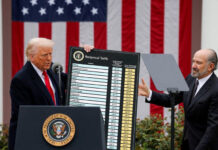SEPTEMBER 14, 2022

India’s foreign exchange reserves are depleting. One part of the Reserve Bank of India’s (RBI) mandate is to intervene in the foreign exchange market, which it does through sales or purchases of dollars in order to curb excessive volatility in rupee. Experts say, this could be a reason as to why India is seeing a depletion of its forex reserves. The country’s forex reserve was at $553.11 billion as of September 2, and within a week, the reserves declined by $8 billion. The forex reserves are the lowest at the moment since October 2020.
Experts and economists have dubbed RBI’s defense of the rupee through dollar sales, amid a globally strengthening greenback, as one of the reasons for the fall in reserves. This is evident from the fact that the decline in foreign exchange reserves in the week ended September 2 was largely on account of a fall in foreign currency assets, which dropped $6.5 billion to $492.12 billion, as per the RBI data.
In August, the RBI had said reserves worth $573 billion were equivalent to 9.4 months of imports projected for the current fiscal year. Reserves fell $89 billion in ten months to $553 billion as of September 2022, but are adequate to cover 8.9 months of imports compared to 4.1 months in May 2013. Import Cover measures the number of months of imports that can be covered with foreign exchange reserves available with the central bank of the country.
“Forex is an insurance cover, you are dipping into insurance cover but insurance is not unlimited, its finite. In [the] current environment, can you continue to do that for 6 months? Will it be able to last for 6 more months? That is where the question of sustainability lies. [In short], can you sustain this? This is a question,” asks veteran economist Vivek Kumar.
India’s trade deficit has been at record levels and the current account deficit is on track to hit a decadal high of 3.5 per cent, which is somewhere around $120 billion in FY23 and which was 1.2 per cent of the GDP at $39 billion in FY22. So far this year, the Indian rupee has plunged by 7 per cent against the American currency.
“It is not a huge crisis-like situation for sure. Because we have a lot of forex reserves, we’ve spent a lot of forex reserves, but we continue to have a lot of excess reserves. So, it’s not an alarming situation. But having said that, yes, after three years of remaining in a balance of payments surplus, we are now going to dive into a balance of payment deficit for at least two years,” argues Pranjul Bhandari, Chief Economist, HSBC.
According to Bloomberg, India and Thailand have been among the most aggressive, with reserves declining by about $81 billion and $32 billion, respectively, this year. Reserves dropped by $27 billion in South Korea, $13 billion in Indonesia and $9 billion in Malaysia and the news agency mentioned that depleting reserves are spelling risks for emerging currency in the world.
As per former governor of RBI, D. Subbarao, the current level of forex resources as a proportion of GDP, which in turn is a proportion of external debt, then by those measurements, the present quantity of reserves are significantly better than before.
“But over the last six months, I believe the Reserve Bank has sold about $50 billion in order to defend the exchange rate. So, the market looks not just at the level of reserves, but how rapidly that is depleting. If a bank continues to spend dollars in order to defend the exchange rate and there is a market sense that the reserves are falling faster than expected, the negative impact of that may be quite significant, notwithstanding the fact that the level of the reserves itself is at a [relatively] safe level,” the former governor explains.







































































































